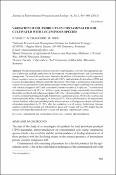Options
Variation of oil products in contaminated soil cultivated with leguminous species
Date issued
2013
Author(s)
Abstract
The phytoremediation of destroyed soil by anthropogenic activities with appropriate species of plants has multiple applications in the treatment of contaminated areas and environmental
management. The aim of the study was to determine the abilities of Onobrychis viciifolia species to
form a vegetative cover on contaminated soil with 2.86% total petroleum hydrocarbons (TPH) and
to assess the degradation efficiency from the rhizosphere. This study is performed on experimental
variants of contaminated soil in the absence/presence of the fertilizer agent combined/non-combined
with volcanic indigenous tuff. Each experimental variant was done in 3 replicates. The fertilization
of contaminated soil with 50 t ha–1 fertilizer agent, municipal sludge anaerobically bio-stabilized
(biosolids), combined with indigenous volcanic tuff, 5 t ha–1, determined the vegetation of Onobrychis
viciifolia, resistant to prolonged drought. Furthermore, leguminous species, Onobrychis viciifolia, has
demonstrated the ability to biodegrade oil products (TPH). The results obtained on the experimental
variants fertilized with municipal sludge in the absence/presence of indigenous volcanic tuff showed
oil products degradation by 55–70%, after the vegetative cycle (8 weeks). Furthermore, biomass
quantity resulted from treated soil with fertilizer agent and volcanic tuff was 50% higher than the
amount of biomass that resulted from volcanic tuff untreated experimental variants.
management. The aim of the study was to determine the abilities of Onobrychis viciifolia species to
form a vegetative cover on contaminated soil with 2.86% total petroleum hydrocarbons (TPH) and
to assess the degradation efficiency from the rhizosphere. This study is performed on experimental
variants of contaminated soil in the absence/presence of the fertilizer agent combined/non-combined
with volcanic indigenous tuff. Each experimental variant was done in 3 replicates. The fertilization
of contaminated soil with 50 t ha–1 fertilizer agent, municipal sludge anaerobically bio-stabilized
(biosolids), combined with indigenous volcanic tuff, 5 t ha–1, determined the vegetation of Onobrychis
viciifolia, resistant to prolonged drought. Furthermore, leguminous species, Onobrychis viciifolia, has
demonstrated the ability to biodegrade oil products (TPH). The results obtained on the experimental
variants fertilized with municipal sludge in the absence/presence of indigenous volcanic tuff showed
oil products degradation by 55–70%, after the vegetative cycle (8 weeks). Furthermore, biomass
quantity resulted from treated soil with fertilizer agent and volcanic tuff was 50% higher than the
amount of biomass that resulted from volcanic tuff untreated experimental variants.
Files
Loading...
Name
2013_3_Contaminated_soil.pdf
Size
222.79 KB
Format
Adobe PDF
Checksum
(MD5):f092d9812a924af574485f556c27ddd7